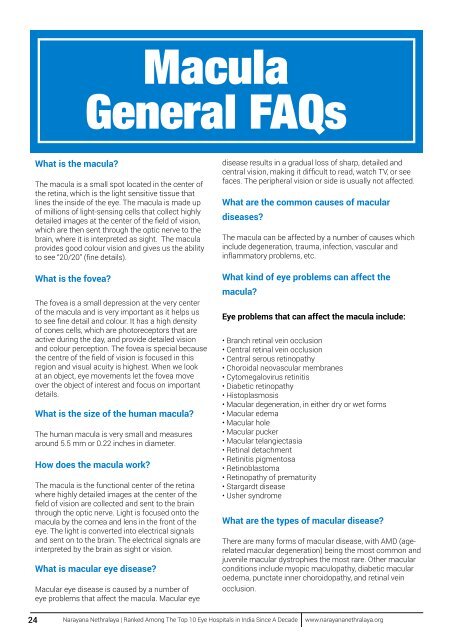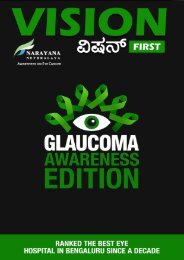Vision First July 2018 English
You also want an ePaper? Increase the reach of your titles
YUMPU automatically turns print PDFs into web optimized ePapers that Google loves.
What is the macula?<br />
Macula<br />
General FAQs<br />
The macula is a small spot located in the center of<br />
the retina, which is the light sensitive tissue that<br />
lines the inside of the eye. The macula is made up<br />
of millions of light-sensing cells that collect highly<br />
detailed images at the center of the field of vision,<br />
which are then sent through the optic nerve to the<br />
brain, where it is interpreted as sight. The macula<br />
provides good colour vision and gives us the ability<br />
to see “20/20” (fine details).<br />
What is the fovea?<br />
The fovea is a small depression at the very center<br />
of the macula and is very important as it helps us<br />
to see fine detail and colour. It has a high density<br />
of cones cells, which are photoreceptors that are<br />
active during the day, and provide detailed vision<br />
and colour perception. The fovea is special because<br />
the centre of the field of vision is focused in this<br />
region and visual acuity is highest. When we look<br />
at an object, eye movements let the fovea move<br />
over the object of interest and focus on important<br />
details.<br />
What is the size of the human macula?<br />
The human macula is very small and measures<br />
around 5.5 mm or 0.22 inches in diameter.<br />
How does the macula work?<br />
The macula is the functional center of the retina<br />
where highly detailed images at the center of the<br />
field of vision are collected and sent to the brain<br />
through the optic nerve. Light is focused onto the<br />
macula by the cornea and lens in the front of the<br />
eye. The light is converted into electrical signals<br />
and sent on to the brain. The electrical signals are<br />
interpreted by the brain as sight or vision.<br />
What is macular eye disease?<br />
Macular eye disease is caused by a number of<br />
eye problems that affect the macula. Macular eye<br />
disease results in a gradual loss of sharp, detailed and<br />
central vision, making it difficult to read, watch TV, or see<br />
faces. The peripheral vision or side is usually not affected.<br />
What are the common causes of macular<br />
diseases?<br />
The macula can be affected by a number of causes which<br />
include degeneration, trauma, infection, vascular and<br />
inflammatory problems, etc.<br />
What kind of eye problems can affect the<br />
macula?<br />
Eye problems that can affect the macula include:<br />
• Branch retinal vein occlusion<br />
• Central retinal vein occlusion<br />
• Central serous retinopathy<br />
• Choroidal neovascular membranes<br />
• Cytomegalovirus retinitis<br />
• Diabetic retinopathy<br />
• Histoplasmosis<br />
• Macular degeneration, in either dry or wet forms<br />
• Macular edema<br />
• Macular hole<br />
• Macular pucker<br />
• Macular telangiectasia<br />
• Retinal detachment<br />
• Retinitis pigmentosa<br />
• Retinoblastoma<br />
• Retinopathy of prematurity<br />
• Stargardt disease<br />
• Usher syndrome<br />
What are the types of macular disease?<br />
There are many forms of macular disease, with AMD (agerelated<br />
macular degeneration) being the most common and<br />
juvenile macular dystrophies the most rare. Other macular<br />
conditions include myopic maculopathy, diabetic macular<br />
oedema, punctate inner choroidopathy, and retinal vein<br />
occlusion.<br />
How can macular diseases be<br />
classified?<br />
Macular diseases can be subdivided<br />
into those with and without choroidal<br />
neovascularization (CNV). The layers of<br />
the retinal can be damaged by diseases<br />
like macular degeneration, which leads<br />
to the growth of new blood vessels<br />
(neovascularization) in the choroid layer<br />
of the eye. These abnormal blood vessels<br />
can break through the barrier between the<br />
choroid and the retina and leak or bleed<br />
into the retina leading to blurry, darkened or<br />
distorted vision.<br />
Macular diseases not associated<br />
with CNV include:<br />
• Age-related macular degeneration (dry<br />
type)<br />
• Diabetic macular edema<br />
• Macular hole<br />
• Epiretinal membrane<br />
• Central serous chorioretinopathy<br />
Macular diseases associated with CNV include:<br />
• Age-related macular degeneration (wet type)<br />
• High myopia macular degeneration<br />
• Idiopathic CNV<br />
• Idiopathic polypoidal choroidal vasculopathy<br />
• Chorioditis of various causes<br />
What happens when the macula gets<br />
damaged?<br />
The macula is the central and most sensitive area of<br />
the retina. It provides the important, functional vision<br />
that we need for reading, close work, and to see things<br />
in detail that need a lot of close focus. The macula’s<br />
structure needs to be undisturbed and relatively dry<br />
in order for the images to be clear and vision to be<br />
good. When the cells of the macula deteriorate or get<br />
damaged, the center of the field of view gets affected. In<br />
some cases, the neurosensory retina detaches from the<br />
epithelium. In advanced degeneration, the macula may<br />
bleed and leak fluid, and drusen spots (yellow deposits)<br />
may appear.<br />
How does damage to the macula affect<br />
vision?<br />
Similar to the film in a camera, a healthy retina produces<br />
a clear image. But if the macula is damaged, the image<br />
will not be clear. The macula is responsible for central<br />
(sharp, straight-ahead) vision, which allows you to see<br />
fine details clearly, in your direct line of sight. Whenever<br />
we look at an object, the image focuses on the macula<br />
and the brain builds up details of what we see. When the<br />
cells of the macula deteriorate, images are not received<br />
correctly by the brain, causing distortion of an image’s<br />
lines and size. The center of your field of view (all the<br />
things you see in fine detail) may appear misty, blurry,<br />
distorted, or dark.<br />
How does macular damage affect daily life?<br />
While the rest of the retina provides peripheral vision,<br />
the macula is rich in photoreceptor nerve cells that<br />
enable us to see fine details and colour. The loss of<br />
central vision in macular degeneration can hinder<br />
simple everyday tasks such as the ability to see faces,<br />
read, write, drive, using the stairs, or do close work<br />
such as cooking, dialling a telephone, or working on a<br />
computer.<br />
What are maculopathy and macular<br />
dystrophy?<br />
Maculopathy or macular dystrophy is a condition where<br />
drusen spots, which are yellow deposits that are made<br />
up of lipids (a fatty protein), appear on the macula,<br />
possibly accompanied by some scarring. Drusen spots<br />
indicate that there is some problem with the macula.<br />
Studies show that people with drusen spots (especially<br />
large spots) have an increased risk of developing<br />
macular degeneration.<br />
What are the common symptoms of macular<br />
diseases?<br />
Macula is important for central vision, fine visualization<br />
and colour differentiation. Patients suffering from<br />
macular diseases may experience the following<br />
symptoms:<br />
• Blurring of central vision - This may be characterised<br />
24 Narayana Nethralaya | Ranked Among The Top 10 Eye Hospitals in India Since A Decade www.narayananethralaya.org Narayana Nethralaya | Ranked Among The Top 10 Eye Hospitals in India Since A Decade www.narayananethralaya.org 25

















